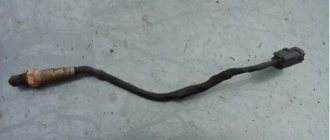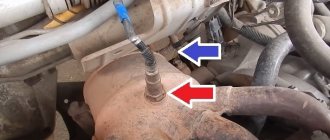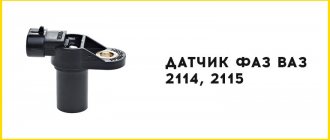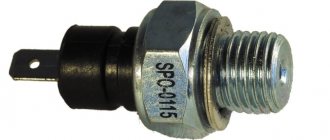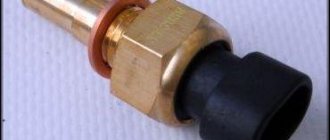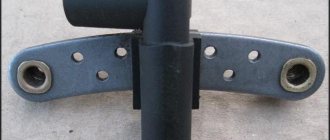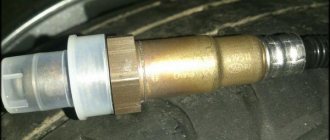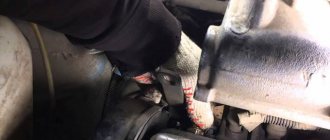The lambda probe or oxygen sensor is designed to monitor the amount of oxygen in the exhaust gases. The excess of air above the mixture is called “enrichment”, and the reverse process is called “leanness”.
Both factors negatively affect the functionality of the motor:
- Power reduction;
- Unstable operation at idle, under load;
- Increased fuel consumption.
In cars of the Lada (VAZ) family, one oxygen controller is preinstalled. European and American models have two built-in sensors: diagnostic and control.
They are similar in appearance, identical in size, but perform different functions.
Purpose of the oxygen sensor on the VAZ 2115
This sensor estimates the percentage of oxygen in the exhaust gas mixture. The lambda probe helps to identify both “enrichment” - the phenomenon of saturation of the fuel-air mixture with air, and “leanness” - the opposite phenomenon. Both of these processes are highly undesirable, so it is necessary that the oxygen sensor is not only present, but also functioning correctly.
The sensor also serves to reduce harmful emissions into the environment. With the advent of EURO standards, strict toxicity requirements began to be imposed on cars, and the DC is designed to control the exhaust gases released by the car during operation.
Ways to deceive the electronic control unit
There are three more ways to restore the engine to its former performance without buying a new oxygen sensor. Without a doubt, they were invented by our craftsmen. And they consist in the fact that it is necessary to mislead the electronic control unit so that it does not notice errors in the operation of the sensor.
The first method is mechanical. To implement this, a special spacer (bushing) is screwed in between the lambda probe and the manifold body (intake pipe). Its use allows you to distance the sensor contacts from the exhaust gases. Thus, the amount of oxygen between them artificially increases, and the electronic control unit “remains satisfied” with the result obtained.
A similar VAZ 2114 lambda probe costs about 500 rubles. And if you have a lathe, you can make it yourself.
The next way to deceive the ECU is electronic. Its essence is to install a primitive converter in the sensor circuit, consisting of one resistor (1 MΩ) soldered into the gap in the blue wire of the connector and one capacitor (1 μF) connected between the blue and white wires. As a result of such a simple deception, the electronic control unit will constantly receive a signal of the required voltage and perceive the operation of the lambda probe as proper.
Alternatively, you can also reflash the controller by changing its software. But it is better to entrust such manipulations with the “brain” of the engine to specialists.
The principle of operation of the oxygen sensor on the VAZ 2115
The lambda probe begins to function at a temperature of 300ᵒC and above. Exhaust gases enter the working surface of the device. The device reacts to the difference between the oxygen level in the exhaust gases and the environment. Then it sends a signal to the electronic engine control unit, which regulates the working fuel-air mixture.
If the exhaust gas parameters exceed the permissible limits, the ECU adjusts the fuel mixture so that the gases reduce their concentration of carbon dioxide and return to normal.
Reasons for reducing the service life of equipment
- Violation of vehicle operating conditions, failure to comply with scheduled technical inspection deadlines;
- Filling the car with low-quality fuel;
- Purchase and subsequent installation of non-original parts;
- Violation of installation technology;
- Defective parts during manufacturing;
- Damage due to an accident, collision, impact;
- Incorrect operation of the firmware of the electronic control unit.
This is interesting: Air and oil filter Toyota Corolla 120: replacement
Location of the oxygen sensor on the VAZ 2115
Location of the oxygen sensor on the VAZ 2115
In the VAZ-2115 car model, access to the lambda probe can only be gained by climbing under the bottom of the car. For repairs or maintenance, an inspection hole is most often used. You can also use a roadside overpass and a hydraulic lifting mechanism. The oxygen sensor is located on the exhaust pipe between the exhaust manifold coupling and the resonator.
It should be noted that due to its location, the sensor is often susceptible to corrosion due to high temperature and constant contact with water. This leads to frequent problems when trying to turn it out of its seat. Quite often the sensor breaks off, thereby causing a lot of trouble.
Indicators
Lambda indicators may vary, but the car requires certain, optimal parameters.
| Index | Peculiarity |
| Lambda equals one | Theoretically, this is the optimal air ratio, at which the actual amount is equal to the required |
| Lambda is greater than one | Indicates that the air-fuel mixture is lean and therefore the engine is not operating optimally. |
| Lambda is less than one | Under such circumstances, the mixture turns out to be rich and there is an excess of fuel. Because of this, there is a lack of oxygen necessary to burn such an amount of gasoline |
If we talk directly about ideal conditions for the VAZ 2114 and its engines, then the lambda should have a ratio of 14.7 to 1. In other words, the mixture needs to be lean. This is due to the need for a sufficient amount of oxygen on the catalyst to burn CH and CO.
For domestic cars, a modern DC is used, which functions as a threshold element.
Signs of a malfunctioning oxygen sensor
There are several basic signs, thanks to which you can quickly and easily determine whether the lambda probe in a VAZ-2115 car is functioning correctly and whether it functions at all.
And these are the signs:
- Sagging idle speed (dysfunction of the oxygen sensor entails the inability of the speed to remain at the same level at idle; as a rule, the speed drops significantly; first of all, this is caused by the fact that an insufficient lean mixture is supplied for stable operation of the engine at idle).
- Reduced engine power (a lean mixture leads not only to problems with idle speed, but also to a decrease in engine power; in such cases, the car does not go uphill well and accelerates poorly).
- Increased fuel consumption (malfunction of the oxygen sensor can sometimes lead to a significant increase in fuel consumption up to 30%; visually, the exhaust is darker compared to normal operation, and also smells distinctly of gasoline; excessive enrichment of the mixture is easy to determine thanks to the candles: it appears on them black coating).
- Uneven movement during acceleration (if a malfunction occurs in the lambda probe, the car becomes unable to pick up speed quickly and evenly; frequent and sharp jerks occur).
How to check if the sensor is working properly
Checking the sensor is usually carried out with the engine running. There are several ways to check the serviceability of the sensor, suitable for the VAZ-2115 car:
- Using a tester (in this case, it is necessary to determine the voltage, as well as the resistance; the probes must be connected to the connecting terminals and measurements must be taken in different operating modes of the internal combustion engine).
- Using a diagnostic tool or ELM 327 scanner with the OpenDiag program installed on a smartphone.
- An oscilloscope (The advantage of this test is that it allows you to determine the rate of change of voltage, which in a working device should not exceed 0.2-0.3 seconds.)
If the measurement result of at least one of the instruments shows a significant deviation from the norm, then the oxygen sensor must be cleaned or replaced.
Checking the oxygen sensor for functionality
Note! For clarity, the performance test will be shown on the topmost sensor, which is screwed into the exhaust manifold of a 1.6 engine!
1) To check, you will need to stock up on a regular metal clip and a multi-meter that will be equipped with a voltmeter function, or if you don’t have this device, then just stock up on the voltmeter itself.
2) Then you will need to connect an unbent paper clip to the wire connector that also goes with the oxygen sensor, and you need to connect this paper clip to the signal wire that goes to the controller and then connect the positive lead of the ohmmeter to this paper clip, and connect the negative lead for mass, for example, your car engine may be the mass.
Note! The signal wire that goes to the controller is usually painted in different colors, for example, it can be white, black, red-white and other colors, so in order not to be mistaken, open the book on the operation of your car and look at the electrical diagram of your car in it, all these are there the nuances must be described!
3) After everything is connected, get into the car and start it and then carefully monitor the ohmmeter readings, on a cold engine it should show very small numbers, namely somewhere around 0.1-0.3 volts, as it warms up these numbers will you will have to increase, namely in two or three minutes when the engine warms up to operating temperature, the readings should already be in the region of 0.1-0.9 volts (They should fluctuate), if this is the case for you then this will mean that that this sensor is working normally and there is no need to replace it, but if the voltmeter shows, for example, readings of 0.1-0.9 volts very late (On a very hot engine), or these readings are not reached at all, then this will mean that that the sensor is faulty and needs to be replaced.
1. When you buy a new sensor, you will most likely be asked which one you need with heating or not? So, it is best to take this sensor with heating, because as a rule, this sensor begins to work normally only after 300 degrees and above it works as it should, and to heat it up to so many degrees it takes some time and so that it is reduced, we recommend that you install the sensor heated only!
Advice: If you still want to buy a non-heating sensor, then remember once and for all, you will not be able to install it instead of the old sensor if you had this sensor with heating, that is, if the old sensor was without heating, then you can install a non-heating sensor, and if your old sensor was heated, then perhaps you will install a new sensor without heating, but perhaps not!
2. And also, as we noted earlier, replacing this sensor must be done on a not too cold engine, because if the engine is completely cooled down, then, as we all know, the body contracts, as a result of which it will be difficult for you to unscrew this sensor, so it is best Replace this sensor with gloves and a barely warm engine!
3. Oh, yes, the most important thing was not noted, it is advisable to buy sensors exactly the same as those you had before, because on some cars the sensors are installed of a new type, and on some they are installed of the old type and with different power, but each controller is usually configured for what then there is one sensor and therefore, when choosing, it is desirable that the new sensor be exactly the same as the old one!
Why do you need a catalyst?
Usually, when it comes to a catalyst, most motorists only think of a muffler, or rather a can or pipe. In fact, the exhaust system of a car includes several elements: connecting pipes, muffler, resonator, corrugation, catalyst, etc. So:
- The catalytic converter, as the catalyst is called, is a fairly important element of the car and the entire exhaust system.
- One of the main functions assigned to it is the purification of exhaust gases that flow through the pipe. The latest Euro 2 standards require the presence of a catalyst in the exhaust system of the car and a special oxygen sensor.
- The neutralizer itself, despite the fact that it is made of metal and a massive body, is a rather fragile element. He is afraid of severe mechanical damage, and is also quite sensitive to low-quality fuel. Impurities and various dirt residues contained in low-quality gasoline remain on the walls of the catalyst, gradually accumulate there and lead to damage to the part. In Russian conditions, the catalyst fails very quickly. And if, usually, it is designed for 200,000 km of run, then if it comes into daily contact with Russian fuel, it will not withstand even 30,000 km of run.
How much do ball joints cost for a VAZ 2107 price?
It is useful to know what a catalytic converter is made of. And find out how this part works.
As was said, it reduces the amount of harmful substances and impurities that any car with an internal combustion engine emits into the surrounding atmosphere. These are substances dangerous to human health, such as carbon monoxide, nitrogen oxide, etc.
For example, carbon monoxide is a real gas that has neither color nor odor. But it is precisely this that contributes to the appearance of cardiac colic and headaches in people.
As for the design of the catalyst, it consists of a ceramic or often metal honeycomb part. Why honeycombs?
Yes, because the design resembles a honeycomb. On top of these same honeycombs, special precious metals, most often platinum, are sprayed.
Although palladium catalysts are often used in the automotive industry of developed countries.
Repair and replacement of the neutralizer
Replacing the catalyst in a VAZ 2115 is carried out only after analyzing the peculiar sounds emitted by the exhaust system. It may also be an unusual smell or color of the exhaust gas.
Common symptoms of a faulty catalytic converter include a rattling sound, like scraping metal, coming from underneath the car.
In such cases, it is urgently necessary to replace it with a new catalytic converter or a homemade flame arrester, which copes well with the basic functions of the factory catalyst.
The right tool
For work we will need a set of tools:
Attention: The inspection hole is a mandatory element of the work process, onto which the car should be raised. Although in some cases drivers use a regular lift.
Removing the catalyst
- lift the car onto a pit or jack;
- unscrew the bolts securing the converter to the exhaust pipe;
- remove the bolts together with the springs, using a 13mm wrench;
- take a screwdriver with a wide blade and pry off the graphite-containing O-ring;
- remove it;
- proceed to unscrewing the rear mounting bolts (there are also two of them);
- to unscrew, use a 17mm wrench;
- when unscrewing and removing the nuts, hold the bolt from turning with another 17 wrench;
- remove the neutralizer.
Consequences of oil overflow into a car engine
In this video you can see everything with your own eyes
Making a homemade flame arrester
DIY flame arrester
The catalyst has been removed. Now it's time to think about what to replace it with. It is clear that all technical parameters of the system and environmentally friendly exhaust must be retained. By removing the faulty catalyst from the system, we maintain normal dynamics and save approximately two liters of fuel per hundred kilometers.
But this is the case, everything will work if you put something instead of the catalyst. And humanity has not yet come up with anything better than a homemade flame arrester (photo above) (a new catalyst is expensive, and as was said, on Russian roads it behaves like an English gentleman in a white tailcoat).
Making a flame extinguisher with your own hands is no longer a novelty. Even a novice motorist can handle this task; he just needs to follow these step-by-step instructions. If you don’t want to get dirty or waste time, then any car service will undertake to make the flame arrester that is needed but, of course, will charge a good price for it.
In order to begin work on the manufacture of a flame arrester, it is useful to learn a little about the principle of its operation.
In general terms, according to the instructions, it is similar to the operation of the catalyst itself, but the only difference lies in the direct-flow design that distinguishes the flame arrester. Flows of exhaust gases do not linger in it, thereby preventing impurities, which are rich in low-quality fuel, from settling.
Flame arrestors are also sold in stores, but finding one that would be ideal for your car will not be easy. And the price for them is not cheap. Therefore, doing it yourself will come in handy.
We prepare the necessary tools and parts:
- welding machine;
- two metal pipes having different cross-sectional diameters;
- metal brush and sponge - 10 pieces.
- take a pipe that matches the size of the exhaust;
- we make small holes in it along the entire length (about 5-6 millimeters);
DK errors
You can detect the presence of these errors by the yellow light on the check engine panel coming on (or it may not light up). You can read these errors either using the on-board computer or using computer diagnostics.
| Error P0130 | Invalid signal DC 1 | ||
| Error P0131 | Low signal level DC 1 | ||
| Error P0132 | Crankshaft sensor 1 signal high | ||
| Error P0133 | Slow response DC 1 | ||
| Error P0134 | No DC 1 signal | ||
| Error P0135 | Faulty heater DC 1 | ||
| Error P0136 | Ground fault DC 2 | ||
| Error P0137 | Low signal level DC 2 | ||
| Error P0138 | High signal level DC 2 | ||
| Error P0140 | Breakage of DK 2 | ||
| Error P0141 | DK 2 heater malfunction | ||
| Error P1102 | Low resistance of DC 2 heater | ||
| Error P1115 | Faulty DC 2 heating circuit | ||
Most often, errors associated with DC appear due to a malfunction of the heating circuit, as a result of which the sensor gives incorrect parameters.
In this case, you need to look for a broken wire or replace the sensor.
What can the electronic control unit tell you?
If a warning light comes on on the dashboard, indicating errors in engine operation, and its lighting is accompanied by the above problems, it is advisable to test the controller. Today this can be done both at a service station and at home. Of course, if you have a special tester and a laptop (tablet, smartphone) with the appropriate software. When connected, this device will give you codes for possible problems.
For VAZ-2114 vehicles, a malfunctioning lambda probe may indicate its malfunction with the following errors:
- P0130 – incorrect sensor signal;
- P0131 – excessive oxygen level in the exhaust gases;
- P0132 – oxygen content too low;
- P0133 – weak or slow sensor signal;
- P0134 – lack of sensor signal.
Why does the lambda probe die?
We have already clarified above that the service life of the oxygen sensor is 80-160 thousand km. You probably have a question: why is there such a spread in the resource, as much as 80 thousand km? In fact, it depends on the conditions in which the car was operated:
- Bad gasoline, the exhaust of which contains a lot of lead and iron, clogs the sensor electrodes after several fill-ups.
- Poor condition of oil scraper rings and caps. Because of them, oil can get into the mixture, and with it into the exhaust system.
- Due to clamped valves, pops are released into the exhaust system, which destroy the working surface of the sensor.
- Due to an incorrect mixture, ignition timing, as a result of which the sensor overheats, crackling from the high temperature of the converter or catalyst.
Replacing the oxygen sensor
Algorithm for replacing an oxygen sensor (lambda probe):
- Disconnect the battery by removing the negative terminal.
- Locate the lambda probe located on the exhaust manifold.
- Disconnect the connector from the oxygen sensor.
- Disconnect the special clamps with which the sensor wires are attached to the engine parts.
- Unscrew the oxygen sensor.
And so the lambda probe was removed. Then there is a nuance: if the new lambda probe is not identical to the previous one, proper wiring must be carried out before installation. Then everything is quite simple:
- Screw in the sensor
- Tighten with wrench
- Secure the wires
- Connect the sensor to the connector
Important!!! The work must be carried out on a cooled engine, and it is also necessary to undergo computer adaptation of the new sensor.
Useful video
You can find more information on this topic in the video below:
Experts note that when replacing the sensor, some problems may arise, in particular, the device may stick to the pipe. In this case, you should pour WD-40 on it and try to unscrew it. You can also heat the sensor or lightly tap it with a hammer.
When carrying out work to check and replace the oxygen concentration sensor, you need to be careful, because the sensor is installed on the exhaust pipe of the muffler, which heats up to high temperatures when the engine is running. For safety reasons, wait until the engine cools down.
To carry out the work you will need:
Disconnect the block with wires from the sensor.- We connect the negative terminal of the voltmeter to the engine ground, and the positive terminal to terminal B on the block and turn on the ignition. The voltage must be at least 12 volts. If it is smaller or missing, you need to check the battery charge, the health of the power circuit and the computer.
- After this, we connect the negative terminal of the voltmeter to terminal C and the positive terminal to terminal A. The voltage between them should be 0.45 volts. If the voltage is missing or differs by more than 0.02, then you need to check the power circuit and the computer.
- To remove the sensor, cut the clamp securing the wire to the cooling system hose.
- Using a 22mm wrench, unscrew the sensor from the exhaust pipe and remove it from the car.
- Install the new sensor in reverse order. Secure the wire to the hose with a new clamp. After installation, check that the wire does not touch the exhaust pipe of the muffler.
